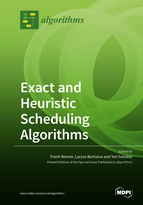Some Results on Shop Scheduling with S-Precedence Constraints among Job Tasks
Round 1
Reviewer 1 Report
This paper investigates a new type of precedence relations in flow shops and job shops. Several special cases are discussed through solution procedures and NP-hardness proof. The s-precedence is very interesting and brings forth many new research questions. The results are solid. I am happy to see the paper published. However, there are several possible improvements to make before it is good for final acceptance.
When traditional precedence is outstanding in job shops or flow shops, the precedence is given among the jobs. The s-precedence of this paper is for operations of the same job. This should be highlighted in article title and in the context body when it is first time mentioned. When addressing a general flow shop, Please use F||C_{\max} rather than F||C_{\max}. Please keep notation and indices consistent. When addressing job processing time, p_{ij} is used in lines 25, 152 and proposition 1. In notation P_i^A (line 40), superscript A is for job A and subscript i is for the operation number. In P^j(A[i]), superscript j is for machine j. All these are rather confusing. When addressing processing time of job i, the machine index j is given as a superscript p^j_i in the first part but a subscript p_{ji} in the second part. Please maintain consistence. Example 2: (1) It is better to use (A, B) to describe processing order rather than {A, B}, the later is for describing a set. (2) Sorry. I cannot see why order (B, A) yields a makespan of 19. Please give its Gantt chart. After Line 199, you use (I, j) top define a block of machines. That is, i and j are used as machine indices. This again contradicts to the use of index I, which was previous used as a job index.
Author Response
Please see the attachment.
Author Response File: ![]() Author Response.pdf
Author Response.pdf
Reviewer 2 Report
In this manuscript, the authors discuss the polynomial exact algorithms for specific job shop problems that a subsequent job can start after its predecessor has been started. The authors provide sufficient technical discussion on such algorithms, some basic cases examples, and the the outlook of future studies. I found this this study reasonably interesting, and the manuscript is also well written. It is worthy to be accepted for publication. My only recommendation is that the authors may include some examples where such type of problems can be apply in research or application, so that it can attract a broader range of readers.
Author Response
Please see the attachment.
Author Response File: ![]() Author Response.pdf
Author Response.pdf
Reviewer 3 Report
COMMENTS:
This work needs to be motivated. It would be interesting to know the applications with s-precedence – nothing is said about this, just a link to other papers. I’ve seen applications where there is an overlap between adjacent activities of a job (i.e. train scheduling) but not otherwise? To my understanding this article considers 2 job problems only. I find this strange and cannot see the value. As an experienced scheduler I have never seen a two job problem. Two machines and many jobs is fine; happens all the time. I'm not a fan of the "maybe this theory will help solve a real life problem at some stage" response. The term “no-idle partial schedule” (NIPS) sounds tragic. There is enough strange jargon around. It would be appreciated if proper/more transparent terms are used. It is odd to me that you would define NIPS first, then explain why it is important second? I don’t understand how you can say all optimal solutions start with a NIPS. What does “start” mean? Where are you getting optimal solutions from in the first place? I think some type of diagram would help to understand case i) – iv) at line 80-82. The references are a bit old. Nothing newer is cited. The Gantt charts have no labelsCORRECTIONS:
Odd language: “with and two jobs (recirculation allowed)” Odd language: “revisits the classical shop scheduling problems” Does not make sense: “in what follows”. The four equations are certainly evident, but why define them at that point? Odd language “from the beginning” and “record them”. Vague comment: “we also determine whether or not” “one of these two different reasons” => “one of two reasons” Does not make sense: “and the thesis follows”Author Response
Please see the attachment.
Author Response File: ![]() Author Response.pdf
Author Response.pdf
Round 2
Reviewer 3 Report
I have no further comments



